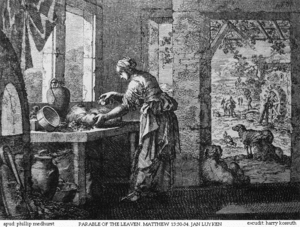Parable of the Leaven
The Parable of the Leaven (also called the Parable of the yeast) is one of the shortest parables of Jesus. It appears in Matthew (13:33) and Luke (13:20–21), as well as in the non-canonical Gospel of Thomas (logion 96). In the canonicals it immediately follows the Parable of the Mustard Seed, which shares this parable's theme of the Kingdom of Heaven growing from small beginnings, and in the Gospel of Thomas it starts a series of three, preceding the Parable of the empty jar and the Parable of the Strong Man.

Narrative
The parable describes what happens when a woman adds leaven (old, fermented dough[1] usually containing lactobacillus and yeast) to a large quantity of flour (about 8 1⁄2 gallons or 38 litres[2]). The living organisms in the leaven grow overnight, so that by morning the entire quantity of dough has been affected.[1]
In the Gospel of Luke, the parable is as follows:
And again he said, “To what shall I compare the kingdom of God? It is like leaven that a woman took and hid in three measures of flour, until it was all leavened.”
— Luke 13:20–21, English Standard Version
Interpretation
This parable is part of a pair,[3] and shares the meaning of the preceding Parable of the Mustard Seed, namely the powerful growth of the Kingdom of God from small beginnings.[1] The final outcome is inevitable once the natural process of growth has begun.[2]Adolf Jülicher identifies three parts to a parable or similitude (extended simile or metaphor): a picture part (Bildhälfte), a reality part (Sachhälfte), and a tertium comparationis.[4] The picture part is a woman making bread with leaven, the reality part is the kingdom of God, and the point of comparison is the powerful growth of the kingdom from small beginnings.
Although leaven symbolises evil influences elsewhere in the New Testament (as in Luke 12:1),[1] it is not generally interpreted that way in this parable.[1][2][3][5][6][7] However, a few commentators do see the leaven as reflecting future corrupting influences in the Church.[8][9]
As with the Parable of the Lost Coin, this parable is part of a pair, in which the first parable describes Jesus' work in terms of agricultural activities of men compared to the second parable with a focus on women's domestic activities.[3] Joel B. Green writes that Jesus "asks people—male or female, privileged or peasant, it does not matter—to enter the domain of a first-century woman and household cook in order to gain perspective on the domain of God."[5]
The large quantity of flour may hint at a planned festive occasion, since the bread produced could feed a hundred people.[3] Three measures of meal was the amount used by Sarah to bake bread when she and Abram were visited by Melchizedek and the angels. It is also the amount used in baking the shewbread for the Temple of the Lord in Israel. Both trees[10] (mustard or otherwise) and leavened bread[11] possess a fractal structure visible to the naked eye.
See also
References
| Wikimedia Commons has media related to The Leaven. |
- I. Howard Marshall 1978, The Gospel of Luke: A commentary on the Greek text, Eerdmans, ISBN 0-8028-3512-0, pp. 561–62.
- John Nolland 2005, The Gospel of Matthew: A commentary on the Greek text, Eerdmans, ISBN 0-8028-2389-0, pp. 553–54.
- Ben Witherington III 1987, Women in the Ministry of Jesus: A study of Jesus' attitudes to women and their roles as reflected in his earthly life, Cambridge University Press, ISBN 0-521-34781-5, pp. 40–41.
- Adolf Jülicher 1910, Die Gleichnisreden Jesu, 2nd ed. (Tübingen: J. C. B. Mohr); James L. Resseguie 2005, Narrative Criticism of the New Testament: An Introduction, Grand Rapids: Baker Academic, 63–64.
- Joel B. Green 1997, The Gospel of Luke, Eerdmans, ISBN 0-8028-2315-7, p. 527.
- John Calvin, Commentary on Matthew, Mark, Luke, Volume 2.
- Daniel J. Harrington 1991, The Gospel of Matthew, Liturgical Press, ISBN 0-8146-5803-2, p. 205.
- Herbert Lockyer 1988, All the Parables of the Bible, Zondervan, ISBN 0-310-28111-3, p. 190.
- G. H. Pember 1881, The great prophecies, Hodder & Stoughton, p. 253.
- Zhang, Dongsheng; Samal, Ashok; Brandle, James R. (2007-05-01). "A method for estimating fractal dimension of tree crowns from digital images". International Journal of Pattern Recognition and Artificial Intelligence. 21 (03): 561–572. doi:10.1142/S0218001407005090. ISSN 0218-0014.
- Gonzales-Barron, Ursula; Butler, Francis (2008-02-01). "Fractal texture analysis of bread crumb digital images". European Food Research and Technology. 226 (4): 721–729. doi:10.1007/s00217-007-0582-3. ISSN 1438-2385.